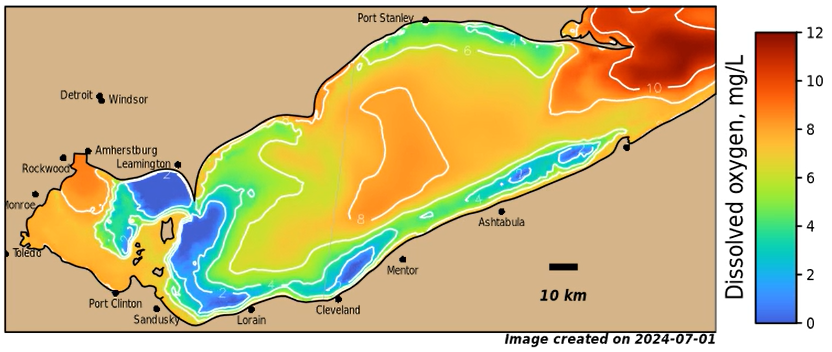
The central basin of Lake Erie provides drinking water to more than 2 million Ohio residents. During the summer, the lake stratifies, with warm water on the top and cold, dense, water near the bottom. Oxygen in this deep water is used up, resulting in low oxygen, or hypoxia. The low oxygen water not only impacts fish and other animals, but also has a different chemical makeup than oxygenated water, which can be problematic for the public water supply. Strong wind events in the summer can cause upwelling, which brings this cold, hypoxic bottom water up to the surface close to shore. This can cause a sudden degradation to the water quality at nearshore drinking water intakes. These events require rapid adjustments to the treatment process in order to maintain drinking water quality. As the upwelling events largely occur with an irregular frequency, local decision makers need timely warnings of the conditions that may cause them.
For the past several years, NOAA’s Great Lakes Environmental Research Lab (GLERL) has been producing a research forecast that predicts the occurrence of hypoxic upwelling events along the Ohio coast. As of this year, 2024, the research forecast has been successfully transitioned to NOAA’s National Centers for Coastal Ocean Science (NCCOS) for long-term operations, providing valuable information to drinking water treatment managers about potential hypoxic events. Over the 2024 season, eleven hypoxic upwelling alerts were issued for the central Ohio coast between July 2 and September 26, with additional notifications issued when hypoxic upwelling events continued for more than three days. The number of alert subscribers increased from 447 to 947 over the forecast season, with notifications targeted to drinking water treatment managers.
The July 2 hypoxic alert was particularly timely, as the event was uncharacteristically early compared to previous years. However, because of the hypoxic alert, water managers were prepared for this event. Another hypoxic upwelling event on August 8th-11th resulted in very high concentrations of manganese, which leads to taste and odor concerns in drinking water, due to a hypoxic event in central Lake Erie. Water treatment managers were successfully able to mitigate and treat with the advanced warning. A researcher from GLERL wrote, “Cleveland Water was able to successfully adjust their treatment methods to ensure continued delivery of quality drinking water. By providing advance notice of hypoxic upwelling events, the Lake Erie Hypoxia Forecast helps public water systems prepare to respond to these events.” Researchers at NOAA NCCOS will be spending the offseason working to evaluate the forecast and assessing its impact during the 2024 summer season.“
